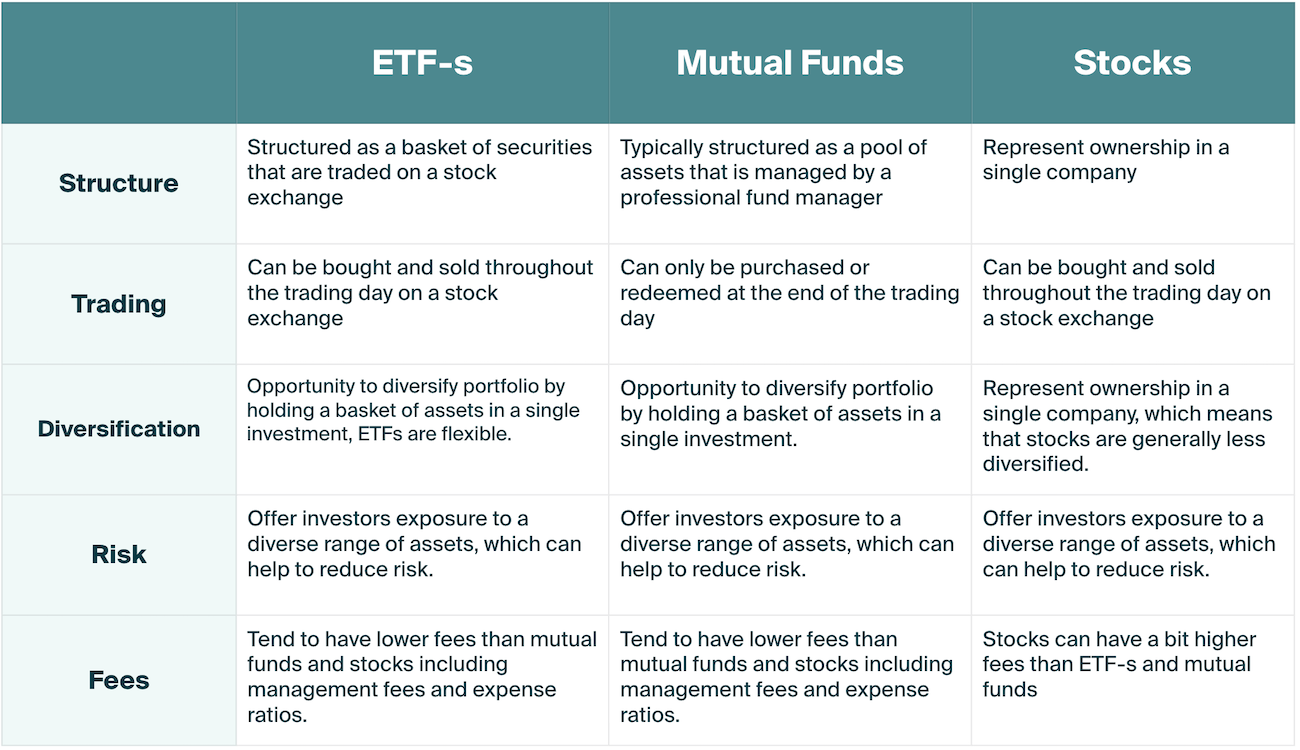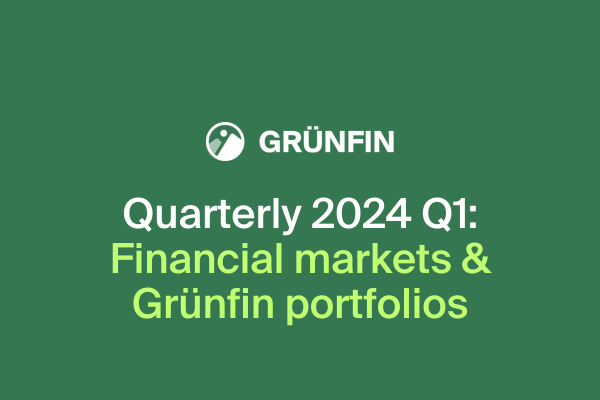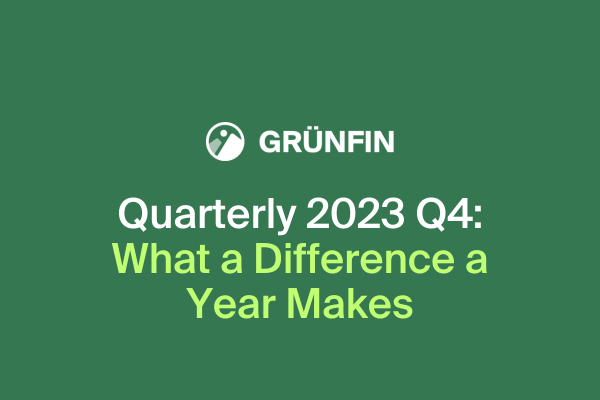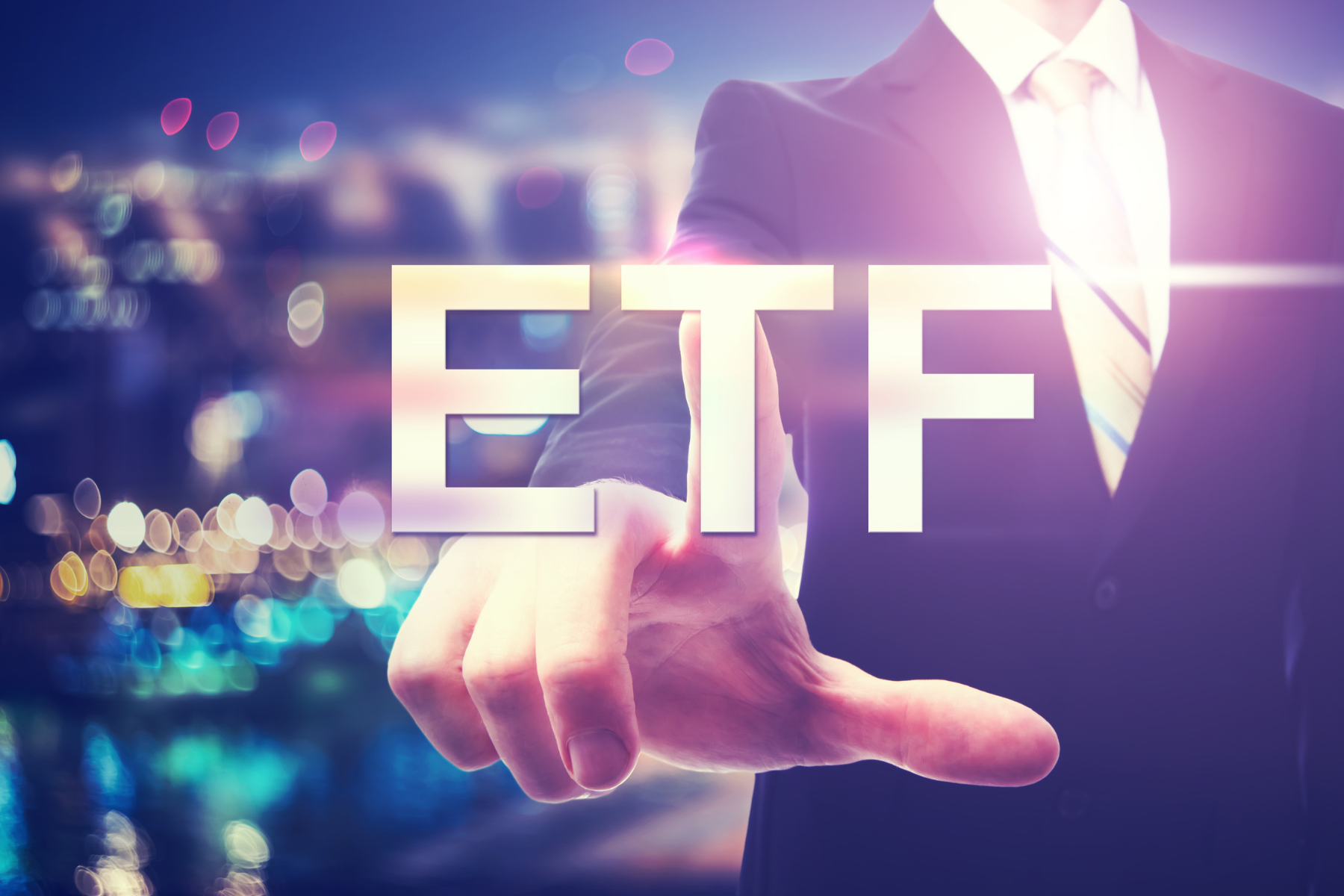We are giving an overview of the following:
- ETF Meaning
- ETF pros
- ETF cons
- Are ETF-s suitable for the beginners
- ETF vs. Mutual Fund vs Stocks
- Types of ETF-s
- How does Grünfin choose ETFs for your portfolio?
ETF Meaning: What is an Exchange Traded Fund (ETF)?
An exchange traded fund (ETF) is a type of investment instrument that tracks the performance of a particular asset or group of assets. ETFs are traded on stock exchanges, just like stocks, which means they can be bought and sold throughout the day.
The philosophy behind using ETFs is that you will hold shares in many large, global companies. This allows for greater diversification of your investment, lower fees and better liquidity.
One of the main advantages of ETFs is their low costs and diversification. Because ETFs track a basket of assets, they can provide investors with exposure to a wide range of securities in a single investment. This can help to reduce the overall risk of an investment portfolio.
There are many different types of ETFs available, including those that track stock indices, commodities, currencies, and bonds. Some ETFs are actively managed, while others are passively managed and track the performance of a specific index.
Overall, ETFs can be a convenient and cost-effective way for investors to gain exposure to a broad range of assets and diversify their investment portfolios.
TIP: You may also be interested more about what are bonds and what are green bonds.
ETF pros: 5 reasons why use an ETF?
There are several reasons why investors might choose to use ETFs in their portfolios:
#1 Diversification
ETFs offer investors the opportunity to diversify their portfolio by holding a basket of assets in a single investment.
This can help to reduce risk and potentially improve returns over the long term.
#2 Lower costs
ETFs often have lower fees than traditional mutual funds, which can make them more appealing to cost-conscious investors.
#3 Liquidity
ETFs are traded on stock exchanges, which means that they can be bought and sold throughout the trading day. This can make it easier for investors to enter and exit positions as needed.
#4 Flexibility
ETFs come in a variety of types, including those that track specific market indexes, sectors, or themes. This allows investors to choose an ETF that aligns with their investment goals and risk tolerance.
#5 Transparency
ETFs must disclose their holdings on a regular basis, which can make it easier for investors to understand exactly what they are investing in.
These are also reasons why we prefer to have ETF-s in your Grünfin portfolios however we have done all the analyzing part to find truly impactful, cost effective and It’s important to note that ETFs are not suitable for all investors.
ETF cons: 3 downsides of ETFs
Like any investment, ETFs come with some potential drawbacks that investors should be aware of:
#1 Market risk
ETFs are subject to market risk, which means that the value of the fund can fluctuate based on the performance of the underlying assets. If the assets in the ETF decline in value, the value of the ETF will also decline.
#2 Tracking error
ETFs are designed to track the performance of a particular basket of assets, but they may not always perfectly replicate the performance of the underlying assets. This is known as tracking error, and it can result in the ETF underperforming or outperforming the underlying assets.
#3 Liquidity risk
Some ETFs may not be as liquid as others, which means that it may be difficult to buy or sell the fund at any given time. This can be especially true for ETFs that track less liquid assets, such as small-cap stocks or emerging market bonds.
It’s important to carefully consider the potential risks and drawbacks of ETFs before including them in your investment portfolio.
Are ETFs are good for beginners?
Yes, ETF- s can e a good choice for beginner investors for several reasons, including the:
- Diversification: With ETF-s you have the opportunity to have many assets under one instrument
- Low costs and fees on purchasing ETF-s
- Transparency: ETFs must disclose their holdings on a regular basis, which can make it easier for investors to understand exactly what they are investing in.
- Ease of use:ETFs are traded on stock exchanges, which means that they can be bought and sold just like individual stocks. This can make them easy to use for beginner investors who may not have a lot of experience with the stock market.
- Flexibility: ETFs come in a variety of types, including those that track specific market indexes, sectors, or themes. This allows investors to choose an ETF that aligns with their investment goals and risk tolerance.
However even there are several reasons why ETF-s are good for the begginners, it is worth to note there are 300 000+ ETF-s to choose from.
Therefore, for the investors who appreciate as passive interaction and possible, it would be also wise to have a look on the platforms that helps with the financial analyzes as well to get you the most suitable ETF-s.
ETF vs Mutual Fund vs Stocks - what are the differences?
Exchange Traded Funds (ETFs), mutual funds and stocks are all types of investment vehicles that allow investors to hold a diversified portfolio of assets.
However, there are some key differences between these all. We put them together in a nice comparison table:

6 Different Types of ETFs
There are several types of ETFs available to investors, including:
#1 Equity ETFs:
These ETFs invest in stocks and can be based on a variety of factors, such as market capitalization, sector, or geographic region.
#2 Bond ETFs:
These ETFs invest in bonds and can be based on a variety of factors, such as credit quality, maturity, or sector.
#3 Commodity ETFs:
These ETFs invest in physical commodities, such as precious metals, oil, or agricultural products.
#4 Currency ETFs:
These ETFs invest in foreign currencies and can be used as a hedge against currency risk or as a way to gain exposure to specific currencies.
#5 Inverse ETFs:
These ETFs aim to generate returns that are opposite to the performance of a particular market or index. Inverse ETFs can be used as a way to hedge against market risk or to speculate on market declines.
#6 Leveraged ETFs:
These ETFs use financial instruments such as futures contracts or options to amplify the returns of the underlying assets.
Leveraged ETFs can be used to increase exposure to a particular market or index, but they also come with increased risk.
How does Grünfin choose ETF-s to your portfolio?
While putting together your investment portfolio, we are following Grünfin’s 7 investment principles to make you a value based, low cost, long term and diversified portfolio.
Our 7 investment principles are:
- We help you build a values-based portfolio.
- We only provide sustainable investment funds that comply with the Sustainable Finance Disclosure Regulation (SFDR Article 8 and Article 9).
- The funds need to satisfy our criteria on our 20+ sustainability criterias
- We believe in a low-cost, diversified, and long-term investment strategy.
- We are independent in providing our service.
- We stand for customer interest.
- Together with you, we truly impact the world.
You can also read why we decided to choose ETFs over the stocks and what is the difference between using Grünfin and buying ETF-s over bank.
You can have your impactful ETF- climate portfolio, [gender portfolio](Grünfin Gender portfolio impact “https://www.grunfin.com/blog/posts/gender-equality-portfolio/"), health portfolio or a mix of those.
These could also be interesting to you

Quaterly news from Grünfin 2024 Q1
Grünfin quaterly news about financial markets and Grünfin sustainable portfolios.

Sustainability's highest standard. Grünfin is now a B-Corp
Certified B Corporations, or B Corps, are companies verified by B Lab, third party, to meet high standards of social and environmental performance, transparency, and accountability.

What a Difference a Year Makes (Grünfin Update & Quarterly Statement)
What happened in financial markets in 2023 and how we see 2024?

